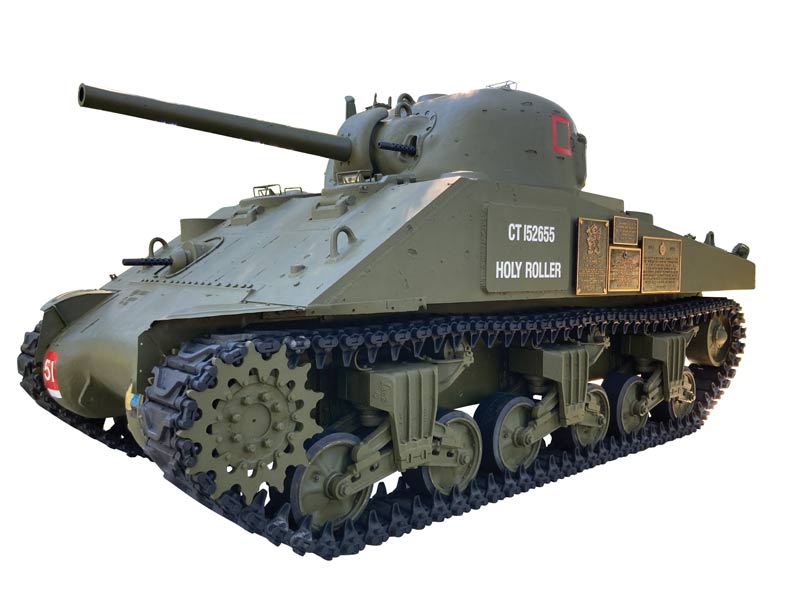
The recently refurbished Sherman tank of the 6th (Reserve) Armoured Regiment (1st Hussars). The vehicle was used on D-Day and subsequently served in 13 other major Second World War battles.[1st Hussars Cavalry Fund]
I’ve wondered whether its mere presence in a city park glorifies war,” wrote journalist Larry Cornies in The London Free Press, “and how the adjective ‘holy’ could possibly be used in the name for an instrument of death and destruction.”
“It” is an M4A2 Sherman tank, a 33-tonne hunk of metal nicknamed “Holy Roller” that was used by the 6th (Reserve) Armoured Regiment, (1st Hussars), on D-Day and today sits in Victoria Park in London, Ont. This past May marked the one-year anniversary of the completion of the tank’s latest preservation initiative.

The tank’s original driver’s seat (above) shows the toll time had taken on the tank, which was first parked in front of the armoury in London, Ont., after its return from Europe. [Courtesy Ian Haley]
Built in Grand Blanc, Mich., in 1942, the tank was shipped to England for the invasion of Europe. After being issued to the 1st Hussars, the regiment’s conventions stipulated that the tank’s name had to start with the letter H. Monikers were thrown around with reckless abandon, with Major Frank White proposing “Hairless Joe,” but it was ultimately the tank’s driver Frank Fowler’s suggestion that stuck.
As it turned out, there seemed to be something divine about the Holy Roller. It hit Juno Beach in the D-Day invasion force’s second wave and survived to serve in 13 other major battles. Many tanks involved in D-Day either sank before they hit the beaches or were disabled on them. The Holy Roller would travel about 4,000 kilometres through France, the Netherlands and Germany. Between D-Day and VE-Day, the 1st Hussars alone lost 346 tanks.
“It ignited in a lot of students the desire
to look back at the history books.”—Stephen Patterson, dean of Fanshawe College’s faculty
of science, trades, and technology
The Holy Roller was retired in 1945 and was saved by the regiment from becoming another donation to the scrap heap. It is one of only two Sherman tanks used by Canadians on D-Day left standing.
“As the prime minister said when he visited…this [the tank] is a national icon,” said Ian Haley, the head of the Holy Roller Memorial Preservation Project and a retired lieutenant-colonel in the 1st Hussars.

After a short stay at the former London Armouries from 1946 to 1948 and eight years on display in the city’s Queens Park, the
Holy Roller was moved to Victoria Park in 1956. By 2017, however, the tank was rusting out. Enter the preservation project, along with volunteers from London’s Fanshawe College. In 2021, the tank was taken to the college’s Centre for Applied Transportation Technology for preservation work.
“It ignited in a lot of students the desire to look back at the history books…which was really quite rewarding,” said Stephen Patterson, dean of Fanshawe’s faculty of science, trades and technology. Coincidentally, Fanshawe was Canada’s first military-connected campus, helping veterans transition into academic and civilian life.
After a year of research, rebuilding and battling for rare parts, the Holy Roller rolled back to the park to mark the regiment’s 150th anniversary.
“You’re always going to get some people who don’t [understand],” said Haley, addressing some critics of the artifact’s home in a city park. “We’re not glorifying war. We are remembering a group of soldiers…who were ordinary people and went and did extraordinary things.
“[Londoners] want to see it in their park,” he said. “They understand.”
BY THE NUMBERS
$227,928
Amount raised in donations by the Holy Roller Memorial Preservation Project
8,000
Approximate hours of work spent in the preservation
of the Holy Roller
2
Surviving Sherman tanks that were used by Canadians
on D-Day
60
Mini iron models of the Holy Roller produced from the tank’s old tracks
Advertisement





















